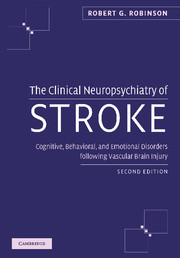 The Clinical Neuropsychiatry of Stroke
The Clinical Neuropsychiatry of Stroke Book contents
- Frontmatter
- Contents
- Preface
- Part I Introduction
- Part II Poststroke depression
- 5 Diagnosis of depression
- 6 Prevalence of depressive disorders
- 7 Phenomenology and specificity of depressive symptoms
- 8 Natural course of depression
- 9 Delayed-onset depression
- 10 Relationship to lesion location
- 11 Relationship of depression to cerebral dominance and structural asymmetries
- 12 Relationship of depression to bilateral hemisphere brain injury
- 13 Relationship of depression to physical impairment
- 14 Relationship to cognitive impairment and treatment
- 15 Relationship of aphasia to depression
- 16 Relationship of depression to social functioning
- 17 Relationship to premorbid risk factors
- 18 Mortality and treatment
- 19 Suicidal thoughts and plans
- 20 Biological markers
- 21 Mechanisms of poststroke depression
- 22 Treatment of poststroke depression
- 23 Prevention of poststroke depression
- Part III Poststroke mania
- Part IV Poststroke anxiety disorders
- Part V Other poststroke disorders
- Index
23 - Prevention of poststroke depression
from Part II - Poststroke depression
Published online by Cambridge University Press: 01 October 2009
- Frontmatter
- Contents
- Preface
- Part I Introduction
- Part II Poststroke depression
- 5 Diagnosis of depression
- 6 Prevalence of depressive disorders
- 7 Phenomenology and specificity of depressive symptoms
- 8 Natural course of depression
- 9 Delayed-onset depression
- 10 Relationship to lesion location
- 11 Relationship of depression to cerebral dominance and structural asymmetries
- 12 Relationship of depression to bilateral hemisphere brain injury
- 13 Relationship of depression to physical impairment
- 14 Relationship to cognitive impairment and treatment
- 15 Relationship of aphasia to depression
- 16 Relationship of depression to social functioning
- 17 Relationship to premorbid risk factors
- 18 Mortality and treatment
- 19 Suicidal thoughts and plans
- 20 Biological markers
- 21 Mechanisms of poststroke depression
- 22 Treatment of poststroke depression
- 23 Prevention of poststroke depression
- Part III Poststroke mania
- Part IV Poststroke anxiety disorders
- Part V Other poststroke disorders
- Index
Summary
Within the past few years, several studies have been published examining the question of whether depression following stroke can be effectively prevented. Given the data that was presented in Chapters 13 on depression and physical impairment, Chapter 14 on depression and cognitive impairment and Chapter 19 on depression and mortality, the obvious conclusion is that methods need to be developed to prevent poststroke depression.
The first study which attempted to prevent poststroke depression was published by Palomaki et al. (1999). This study involved a placebo-controlled trial of mianserin in 100 patients under age 71 admitted to hospital for an acute ischemic stroke. Patients were included if their stroke had occurred <30 days prior to admission and if there was no evidence of other diseases which would confound the assessment. Patients were randomized to mianserin and placebo and stratified according to hemisphere of infarction or brain stem infarction and presence or absence of severe aphasia. The initial dose of mianserin was 10 mg at bedtime and the dosage was increased as tolerated over 10 days to a maintenance level of 60 mg per day. Treatment was continued for 12 months and then gradually withdrawn over 4 weeks.
The mean interval from stroke to beginning of the study was 14.3 days.
- Type
- Chapter
- Information
- The Clinical Neuropsychiatry of StrokeCognitive, Behavioral and Emotional Disorders following Vascular Brain Injury, pp. 271 - 280Publisher: Cambridge University PressPrint publication year: 2006


